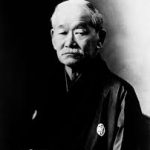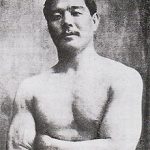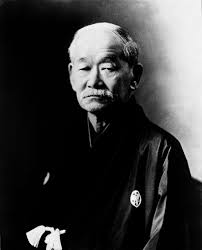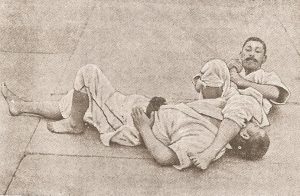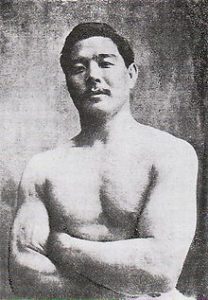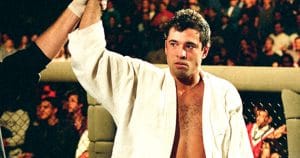Though the name may not imply it, Brazilian Jiu Jitsu has roots in Japanese Judo. Directly translated, “Jiu Jitsu” means “Gentle Art.” To get to the evolution of BJJ that we know and love today, we must trace our steps back to late 1800s Japan…
Jigoro Kano was a well-educated man and renowned martial artist of late 1800s Japan. Combining effective techniques from various disciplines with his own innovations, he founded his own style of combat called Kodokan Judo. One of the most significant improvements Kano made was the addition of “randori” (live sparring against fully resisting opponents) into his students’ training routines. He realized that while the traditional reliance on “kata” (coordinated movement routines) was necessary to understand technique, it was also insufficient and left practitioners unprepared for live combat scenarios. Between his innovative techniques and enlightened training regiments, Kano’s Kodokan Judo style reigned supreme for years.
Up until this point, Kodokan Judo consisted primarily of stand-up throwing methods. When a man named Mataemon Tanabe challenged the Kodokan with his obscure style of classical Jiu Jitsu that incorporated ground fighting techniques, the once-dominant Kodokan was dramatically overwhelmed. Kano immediately saw the disadvantage of his exclusively stand-up style and invited Tanabe to teach ground fighting at his dojo. From that point forward, Kodokan students would practice both stand-up throwing methods and ground fighting techniques.
Around this time a young man named Mitsuyo Maeda came to Kano’s dojo to begin his training. Under Kano, Maeda became one of the greatest fighters in the history of Judo. Using the Kodokan methods, he fought and won grappling matches all over the world. These matches were fought with and without the gi, and across a diverse array of martial arts domains including some “no-holds-barred” matches that involved striking and kicking. After fighting in hundreds of matches, Maeda retired from his professional fighting career in Brazil with an undefeated record. It was here that he opened an academy of “Jiu Jitsu.”
Through Maeda’s venue, the patriarchs of Gracie Jiu Jitsu and pioneers of Brazilian Jiu Jitsu began their own training. Over the generations, the Gracie family studied, tested, forged, and perfected their grappling techniques. When the unassuming Royce Gracie came to America in the early 90s and submitted every one of his opponents in the UFC mixed martial arts championship tournaments, the rest of the world opened their eyes. Brazilian Jiu Jitsu was king.
After that, it was only a matter of time before law enforcement, military personnel, and professional MMA fighters worldwide incorporated BJJ into their training regiments. Soon after, the sport of Brazilian Jiu Jitsu exploded in popularity. Men, women, and children of all ages, sizes, and professions flocked to BJJ for a fun, full body workout, healthy friendships, and of course to pick up on the most effective form of self defense!
Though the name may not imply it, Brazilian Jiu Jitsu has roots in Japanese Judo. Directly translated, “Jiu Jitsu” means “Gentle Art.” To get to the evolution of BJJ that we know and love today, we must trace our steps back to late 1800s Japan…
Jigoro Kano was a well-educated man and renowned martial artist of late 1800s Japan. Combining effective techniques from various disciplines with his own innovations, he founded his own style of combat called Kodokan Judo. One of the most significant improvements Kano made was the addition of “randori” (live sparring against fully resisting opponents) into his students’ training routines. He realized that while the traditional reliance on “kata” (coordinated movement routines) was necessary to understand technique, it was also insufficient and left practitioners unprepared for live combat scenarios. Between his innovative techniques and enlightened training regiments, Kano’s Kodokan Judo style reigned supreme for years.
Up until this point, Kodokan Judo consisted primarily of stand-up throwing methods. When a man named Mataemon Tanabe challenged the Kodokan with his obscure style of classical Jiu Jitsu that incorporated ground fighting techniques, the once-dominant Kodokan was dramatically overwhelmed. Kano immediately saw the disadvantage of his exclusively stand-up style and invited Tanabe to teach ground fighting at his dojo. From that point forward, Kodokan students would practice both stand-up throwing methods and ground fighting techniques.
Around this time a young man named Mitsuyo Maeda came to Kano’s dojo to begin his training. Under Kano, Maeda became one of the greatest fighters in the history of Judo. Using the Kodokan methods, he fought and won grappling matches all over the world. These matches were fought with and without the gi, and across a diverse array of martial arts domains including some “no-holds-barred” matches that involved striking and kicking. After fighting in hundreds of matches, Maeda retired from his professional fighting career in Brazil with an undefeated record. It was here that he opened an academy of “Jiu Jitsu.”
Through Maeda’s venue, the patriarchs of Gracie Jiu Jitsu and pioneers of Brazilian Jiu Jitsu began their own training. Over the generations, the Gracie family studied, tested, forged, and perfected their grappling techniques. When the unassuming Royce Gracie came to America in the early 90s and submitted every one of his opponents in the UFC mixed martial arts championship tournaments, the rest of the world opened their eyes. Brazilian Jiu Jitsu was king.
After that, it was only a matter of time before law enforcement, military personnel, and professional MMA fighters worldwide incorporated BJJ into their training regiments. Soon after, the sport of Brazilian Jiu Jitsu exploded in popularity. Men, women, and children of all ages, sizes, and professions flocked to BJJ for a fun, full body workout, healthy friendships, and of course to pick up on the most effective form of self defense!
